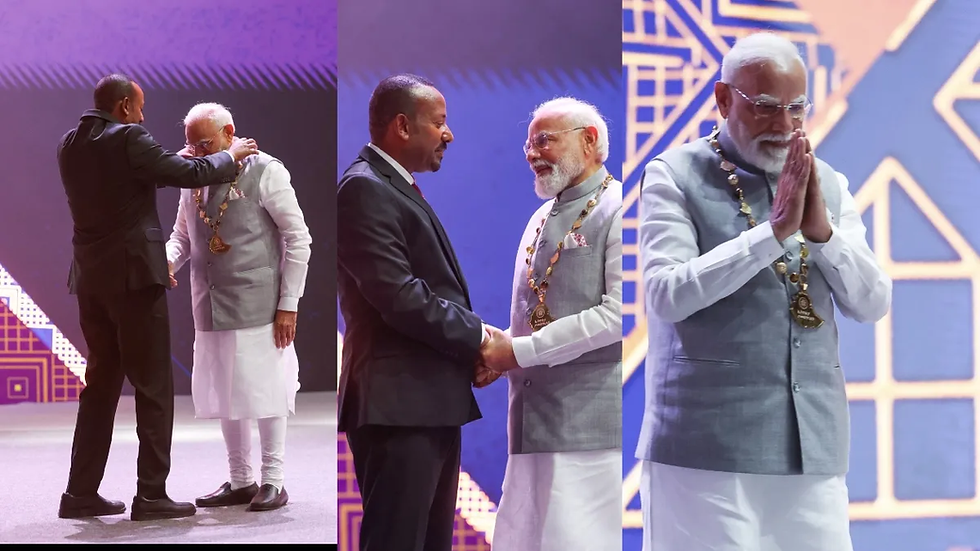India Semiconductor Mission 2.0: PM Modi Unveils a Bold Blueprint for Chipmaking Future
- MGMMTeam

- Sep 2
- 4 min read
At the inauguration of Semicon India 2025, Prime Minister Narendra Modi announced the launch of the India Semiconductor Mission (ISM) 2.0, setting the stage for the country to emerge as a major global player in semiconductor manufacturing. In his address, the Prime Minister described semiconductors as the “digital diamonds” of the 21st century, comparing their strategic value to oil in the last century. He emphasized that it will not be long before chips are “designed in India, made in India, and trusted by the world.”
The event marked not just a policy announcement, but also the symbolic handover of India’s first indigenous chip—the Vikram 32-bit processor—to the Prime Minister by IT Minister Ashwini Vaishnaw. This milestone underscored India’s determination to advance from being a consumer market to a credible producer in the global semiconductor value chain.

Commercial Chip Production and Growing Investments
PM Modi confirmed that India will begin commercial chip production by the end of 2025, a timeline that highlights both ambition and urgency. So far, ten semiconductor units have been approved under the national mission, drawing investments worth $18 billion. According to government projections, India’s semiconductor market, valued at $38 billion in 2023, is set to touch $100–110 billion by 2030.
The initiative is not confined to domestic efforts alone. International partnerships are increasingly becoming central to India’s strategy. Japan has pledged investments worth ¥10 trillion (around $68 billion) for semiconductors and artificial intelligence, while global firms such as ASML, Applied Materials, and Tokyo Electron are actively engaging with Indian stakeholders. These collaborations point to India’s growing role in shaping the next phase of global semiconductor supply chains.
Expanding the Mission: ISM 2.0’s Strategic Focus
While the first phase of the semiconductor mission primarily focused on establishing fabrication plants and chip assembly units, ISM 2.0 takes a broader view. It seeks to integrate the entire ecosystem, ranging from equipment manufacturers and material suppliers to IP-driven chipset developers across industries such as automotive, defense, and healthcare.
A strong emphasis is being placed on next-generation technologies like silicon carbide (SiC) wafer manufacturing, which is vital for electric vehicles, aerospace, and high-performance industrial applications. A major project in Bhubaneswar, led by SicSem Private Ltd., is already in progress to establish India’s capacity in this domain.
Additionally, new incentives under ISM 2.0 will support ancillary industries and SMEs, helping them reduce production costs by 15–30 percent compared to global benchmarks. This is expected to make India’s semiconductor sector globally competitive while also nurturing a sustainable ecosystem within the country.
Infrastructure and Industry Partnerships
India’s semiconductor roadmap also rests on major infrastructure projects. In Uttar Pradesh, the HCL-Foxconn joint venture is setting up a fabrication plant near Jewar airport, slated to begin operations in 2027. In Assam, Tata Semiconductor Assembly and Test Pvt. Ltd. (TSAT) is building the nation’s first greenfield chip assembly facility at Jagiroad, with an investment of ₹27,000 crore and a promise of creating more than 25,000 jobs.
Parallelly, the government is modernizing the Semi-Conductor Laboratory (SCL) in Mohali with investments of up to $2 billion. This facility has already played a key role in supporting ISRO’s Mars Orbiter Mission and indigenous processor development, and its modernization will help India strengthen its research and prototyping capabilities.
Global Engagement at Semicon India 2025
The scale of international participation at Semicon India 2025 further illustrates India’s rising importance. The exhibition has expanded from fewer than 200 exhibitors in 2024 to over 350 this year, with more than 1,100 booths. Delegates from 33 countries, including the United States, Japan, Singapore, South Korea, and the Netherlands, are attending, alongside over 50 CXOs from leading global firms. Notably absent, however, is China—a reminder of the geopolitical dynamics that shape the global chip industry.
The MGMM Outlook
At the launch of Semicon India 2025, Prime Minister Narendra Modi unveiled the India Semiconductor Mission (ISM) 2.0, signaling a transformative leap in India’s technological ambitions. Describing semiconductors as the “digital diamonds” of the century, he emphasized India’s vision of chips being designed, manufactured, and globally trusted from within the country. The event also saw a symbolic milestone—the handover of the Vikram 32-bit indigenous processor to the Prime Minister—showcasing India’s shift from being a consumer market to becoming a credible player in chip production. With commercial production targeted by the end of 2025 and $18 billion worth of investments already secured, the mission reflects both urgency and determination to place India firmly on the global semiconductor map.
ISM 2.0 moves beyond just chip fabrication by focusing on an integrated ecosystem that connects suppliers, manufacturers, and innovators across sectors like defense, healthcare, and electric vehicles. Major projects such as SicSem’s silicon carbide wafer facility in Bhubaneswar, Tata’s assembly plant in Assam, and the HCL-Foxconn fabrication unit in Uttar Pradesh highlight the scale of ambition. International collaboration is central, with Japan pledging massive investments and global firms like ASML and Applied Materials actively engaging with India. The modernization of Mohali’s Semi-Conductor Laboratory further strengthens research and prototyping capacity, while the growing global participation at Semicon India underscores India’s rising importance in shaping the semiconductor supply chain of the future.
(Sources: Hindustan Times, Times of India, Economic Times)




Comments